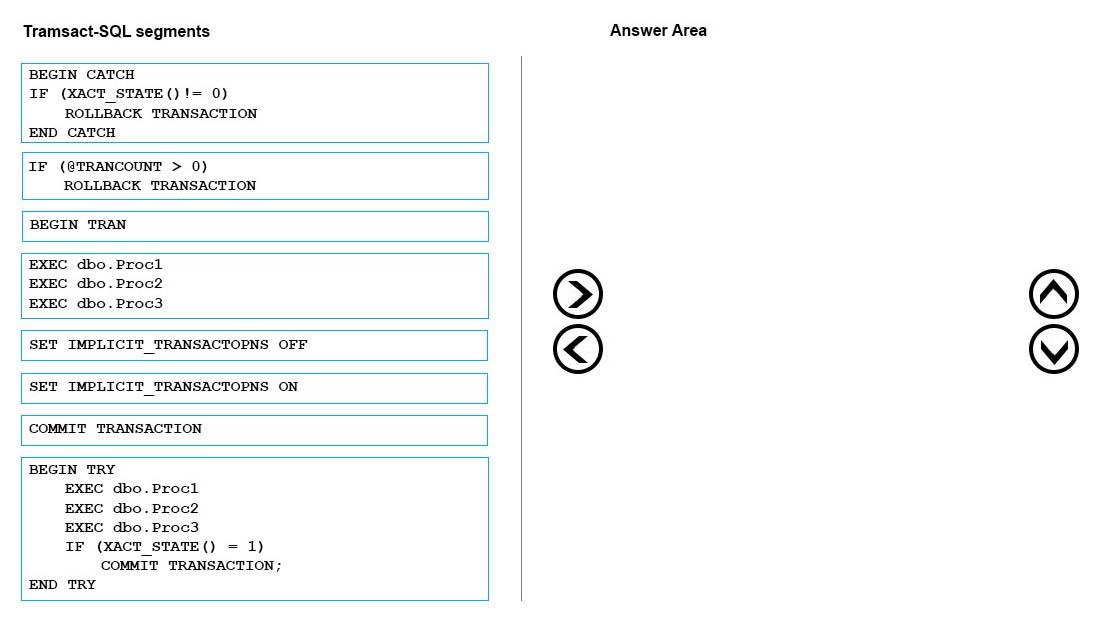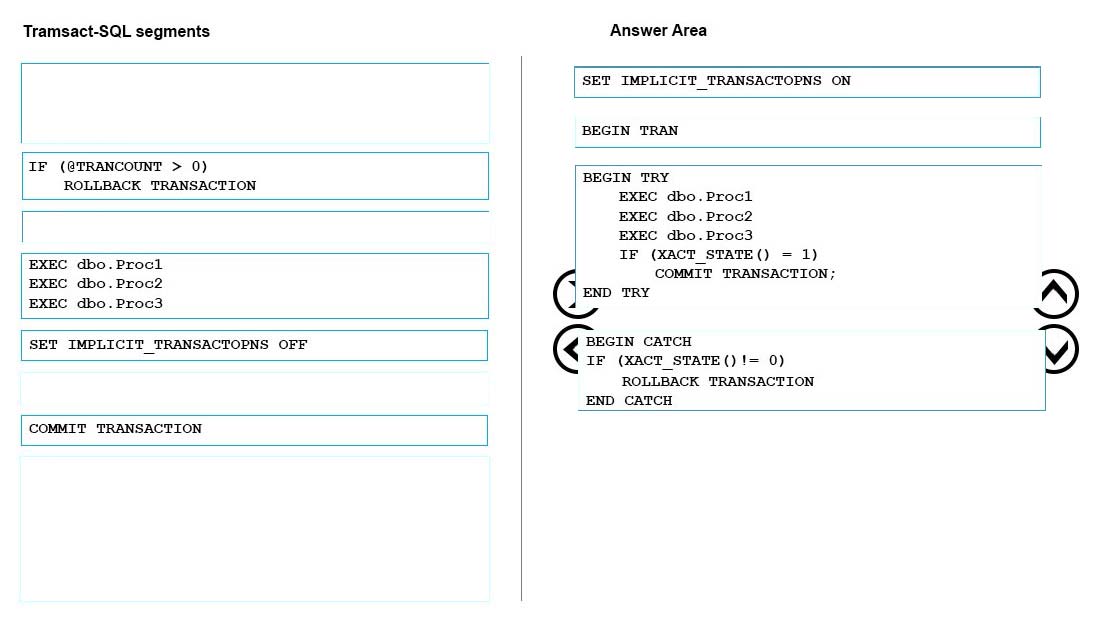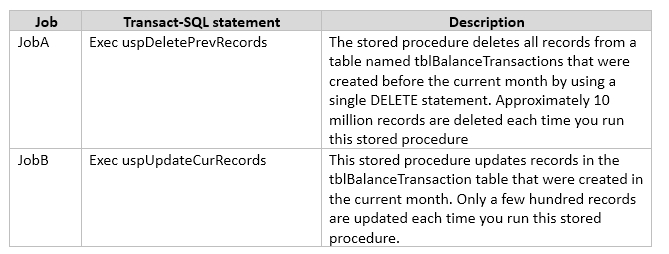Microsoft 70-762 Exam Practice Questions (P. 4)
- Full Access (178 questions)
- Six months of Premium Access
- Access to one million comments
- Seamless ChatGPT Integration
- Ability to download PDF files
- Anki Flashcard files for revision
- No Captcha & No AdSense
- Advanced Exam Configuration
Question #16
DRAG DROP -
You have a database that contains three encrypted store procedures named dbo.Proc1, dbo.Proc2 and dbo.Proc3. The stored procedures include INSERT,
UPDATE, DELETE and BACKUP DATABASE statements.
You have the following requirements:
- You must run all the stored procedures within the same transaction.
- You must automatically start a transaction when stored procedures include DML statements.
- You must not automatically start a transaction when stored procedures include DDL statements.
You need to run all three stored procedures.
Which four Transact-SQL segments should you use to develop the solution? To answer, move the appropriate Transact-SQL segments to the answer area and arrange then in the correct order.
Select and Place:

You have a database that contains three encrypted store procedures named dbo.Proc1, dbo.Proc2 and dbo.Proc3. The stored procedures include INSERT,
UPDATE, DELETE and BACKUP DATABASE statements.
You have the following requirements:
- You must run all the stored procedures within the same transaction.
- You must automatically start a transaction when stored procedures include DML statements.
- You must not automatically start a transaction when stored procedures include DDL statements.
You need to run all three stored procedures.
Which four Transact-SQL segments should you use to develop the solution? To answer, move the appropriate Transact-SQL segments to the answer area and arrange then in the correct order.
Select and Place:

Correct Answer:

Note:
Implicit transaction mode remains in effect until the connection executes a SET IMPLICIT_TRANSACTIONS OFF statement, which returns the connection to autocommit mode. In autocommit mode, allindividual statements are committed if they complete successfully.
When a connection is in implicit transaction mode and the connection is not currently in a transaction, executing any of the following statements starts a transaction:
ALTER TABLE (DDL)
FETCH -
REVOKE -
BEGIN TRANSACTION -
GRANT -
SELECT -
CREATE (DDL)
INSERT -
TRUNCATE TABLE -
DELETE (DML)
OPEN -
UPDATE (DML)
DROP (DDL)
Note 2: XACT_STATE returns the following values.
1 The current request has an active user transaction. The request can perform any actions, including writing data and committing the transaction. The transaction is committable.
-1 The current request has an active user transaction, but an error has occurred that has caused the transaction to be classified as an uncommittable transaction.the transaction is uncommittable and should be rolled back.
0 There is no active user transaction for the current request. Acommit or rollback operation would generate an error.
References:
https://technet.microsoft.com/en-us/library/ms187807(v=sql.105).aspx https://technet.microsoft.com/en-us/library/ms189797(v=sql.110).aspx

Note:
Implicit transaction mode remains in effect until the connection executes a SET IMPLICIT_TRANSACTIONS OFF statement, which returns the connection to autocommit mode. In autocommit mode, allindividual statements are committed if they complete successfully.
When a connection is in implicit transaction mode and the connection is not currently in a transaction, executing any of the following statements starts a transaction:
ALTER TABLE (DDL)
FETCH -
REVOKE -
BEGIN TRANSACTION -
GRANT -
SELECT -
CREATE (DDL)
INSERT -
TRUNCATE TABLE -
DELETE (DML)
OPEN -
UPDATE (DML)
DROP (DDL)
Note 2: XACT_STATE returns the following values.
1 The current request has an active user transaction. The request can perform any actions, including writing data and committing the transaction. The transaction is committable.
-1 The current request has an active user transaction, but an error has occurred that has caused the transaction to be classified as an uncommittable transaction.the transaction is uncommittable and should be rolled back.
0 There is no active user transaction for the current request. Acommit or rollback operation would generate an error.
References:
https://technet.microsoft.com/en-us/library/ms187807(v=sql.105).aspx https://technet.microsoft.com/en-us/library/ms189797(v=sql.110).aspx
send
light_mode
delete
Question #17
HOTSPOT -
You are profiling a frequently used database table named UserEvents. The READ_COMMITED_SNAPSHOT database option is set to OFF.
In the trace results, you observe that lock escalation occurred for one stored procedure even though the number of locks in the database did not exceed memory or configuration thresholds. Events details are provided in the following table:

You need to modify the uspDeleteEvents stored procedure to avoid lock escalation.
How should you modify the stored procedure? To answer, select the appropriate Transact-SQL segments in the answer area.
Hot Area:

You are profiling a frequently used database table named UserEvents. The READ_COMMITED_SNAPSHOT database option is set to OFF.
In the trace results, you observe that lock escalation occurred for one stored procedure even though the number of locks in the database did not exceed memory or configuration thresholds. Events details are provided in the following table:

You need to modify the uspDeleteEvents stored procedure to avoid lock escalation.
How should you modify the stored procedure? To answer, select the appropriate Transact-SQL segments in the answer area.
Hot Area:

Correct Answer:

Delete up to 4000 rows at a time. Keep doing it until all rows have been deleted.
Note that @@ROWCOUNT returns the number of rows affected by the last statement.
References:
https://msdn.microsoft.com/en-us/library/ms187316.aspx

Delete up to 4000 rows at a time. Keep doing it until all rows have been deleted.
Note that @@ROWCOUNT returns the number of rows affected by the last statement.
References:
https://msdn.microsoft.com/en-us/library/ms187316.aspx
send
light_mode
delete
Question #18
You have a database that is experiencing deadlock issues when users run queries.
You need to ensure that all deadlocks are recorded in XML format.
What should you do?
You need to ensure that all deadlocks are recorded in XML format.
What should you do?
- ACreate a Microsoft SQL Server Integration Services package that uses sys.dm_tran_locks.
- BEnable trace flag 1224 by using the Database Cpmsistency Checker(BDCC).
- CEnable trace flag 1222 in the startup options for Microsoft SQL Server.
- DUse the Microsoft SQL Server Profiler Lock:Deadlock event class.
Correct Answer:
C
When deadlocks occur, trace flag 1204 and trace flag 1222 return information that is capturedin the SQL Server error log. Trace flag 1204 reports deadlock information formatted by each node involved in the deadlock. Trace flag 1222 formats deadlock information, first by processes and then by resources.
The output format for Trace Flag 1222 only returns information in an XML-like format.
References:
https://technet.microsoft.com/en-us/library/ms178104(v=sql.105).aspx
C
When deadlocks occur, trace flag 1204 and trace flag 1222 return information that is capturedin the SQL Server error log. Trace flag 1204 reports deadlock information formatted by each node involved in the deadlock. Trace flag 1222 formats deadlock information, first by processes and then by resources.
The output format for Trace Flag 1222 only returns information in an XML-like format.
References:
https://technet.microsoft.com/en-us/library/ms178104(v=sql.105).aspx
send
light_mode
delete
Question #19
You are developing an application that connects to a database.
The application runs the following jobs:

The READ_COMMITTED_SNAPSHOT database option is set to OFF, and auto-content is set to ON. Within the stored procedures, no explicit transactions are defined.
If JobB starts before JobA, it can finish in seconds. If JobA starts first, JobB takes a long time to complete.
You need to use Microsoft SQL Server Profiler to determine whether the blocking that you observe in JobB is caused by locks acquired by JobA.
Which trace event class in the Locks event category should you use?
The application runs the following jobs:

The READ_COMMITTED_SNAPSHOT database option is set to OFF, and auto-content is set to ON. Within the stored procedures, no explicit transactions are defined.
If JobB starts before JobA, it can finish in seconds. If JobA starts first, JobB takes a long time to complete.
You need to use Microsoft SQL Server Profiler to determine whether the blocking that you observe in JobB is caused by locks acquired by JobA.
Which trace event class in the Locks event category should you use?
- ALockAcquired
- BLockCancel
- CLockDeadlock
- DLockEscalation
Correct Answer:
A
The Lock:Acquiredevent class indicates that acquisition of a lock on a resource, such asa data page, has been achieved.
The Lock:Acquired and Lock:Released event classes can be used to monitor when objects are being locked, the type of locks taken, and for how long the locks were retained. Locks retained for long periods of time may cause contention issues and should be investigated.
A
The Lock:Acquiredevent class indicates that acquisition of a lock on a resource, such asa data page, has been achieved.
The Lock:Acquired and Lock:Released event classes can be used to monitor when objects are being locked, the type of locks taken, and for how long the locks were retained. Locks retained for long periods of time may cause contention issues and should be investigated.
send
light_mode
delete
Question #20
Note: This question is part of a series of questions that present the same scenario. Each question in the series contains a unique solution. Determine whether the solution meets the stated goals.
You have a database named dbReporting. Users run a large number of read-only ad hoc queries against the database. The application and all ad hoc queries use default database transaction isolation levels. You set the value of the READ_COMMITTED_SNAPSHOT database option to ON.
You have an application that updates 10 tables sequentially and modifies a large volume of records in a single transaction. The updates are isolated from each other.
Users report an error which indicates that the version store us full.
You need to reduce the number of occurrences of the error.
Solution: You increase the maximum database size for the tempdb database.
Does the solution meet the goal?
You have a database named dbReporting. Users run a large number of read-only ad hoc queries against the database. The application and all ad hoc queries use default database transaction isolation levels. You set the value of the READ_COMMITTED_SNAPSHOT database option to ON.
You have an application that updates 10 tables sequentially and modifies a large volume of records in a single transaction. The updates are isolated from each other.
Users report an error which indicates that the version store us full.
You need to reduce the number of occurrences of the error.
Solution: You increase the maximum database size for the tempdb database.
Does the solution meet the goal?
- AYes
- BNo
Correct Answer:
A
References:
https://docs.microsoft.com/en-us/sql/relational-databases/databases/tempdb-database?view=sql-server-2017
A
References:
https://docs.microsoft.com/en-us/sql/relational-databases/databases/tempdb-database?view=sql-server-2017
send
light_mode
delete
All Pages
